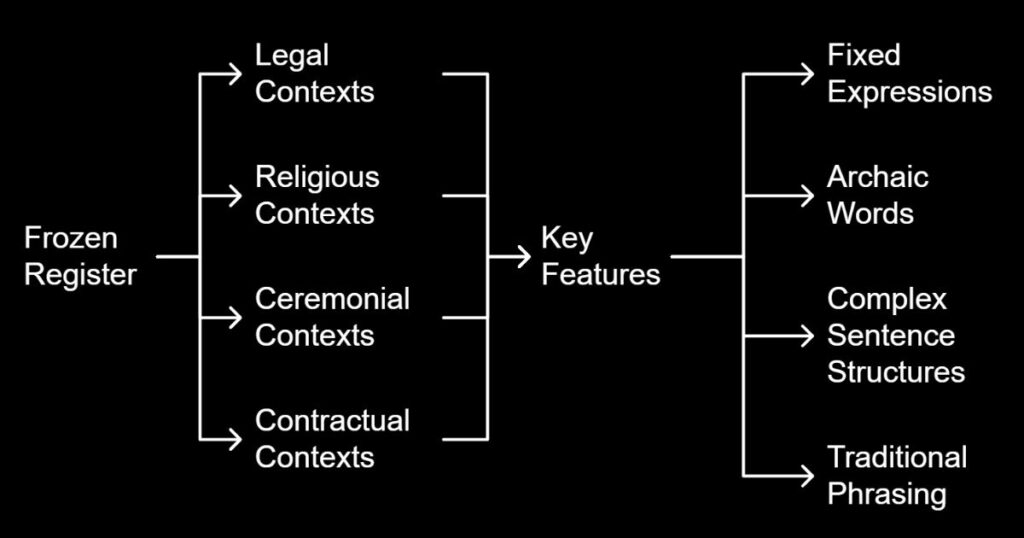Ever notice how you speak differently to your best friend versus your boss? That’s language registers in action! Moving from casual to formal English is like changing clothes for different occasions. As a language teacher for over a decade, I’ve helped countless students master these shifts in speaking style. Let’s explore how you can smoothly switch between different language registers and always say the right thing at the right time.
Contents
ToggleThe Five Language Registers With Examples
1. Frozen Register
Used in unchanging, highly formal contexts.
Examples:
- Legal: “I do solemnly swear to tell the truth, the whole truth, and nothing but the truth.”
- Religious: “Dearly beloved, we are gathered here today…”
- Ceremonies: “By the power vested in me…”
- Contracts: “The party of the first part hereby agrees…”
Key Features:
- Fixed expressions
- Archaic words
- Complex sentence structures
- Traditional phrasing
Real-life situations:
- Court proceedings
- Wedding ceremonies
- Official oaths
- Constitutional texts

2. Formal Register
Used in professional and academic settings.
Examples:
- Casual: “Thanks for reading my email.”
- Formal: “Thank you for your attention to this matter.”
Professional Email Example: Casual: “Hey, just checking if you got my report?” Formal: “I am writing to confirm your receipt of the quarterly report submitted on March 15th.”
Academic Writing Example: Casual: “This study shows that kids learn better with breaks.” Formal: “The research demonstrates that implementing structured break periods enhances student learning outcomes.”
Key Features:
- No contractions (cannot vs. can’t)
- Full phrases
- Technical vocabulary
- Complete sentences
3. Consultative Register
Used in professional services and business interactions.
Examples: Doctor’s Office:
- Casual: “What’s wrong?”
- Consultative: “What symptoms are you experiencing today?”
Customer Service:
- Casual: “What’s the problem?”
- Consultative: “How may I assist you today?”
Teaching:
- Casual: “Let’s learn about frogs.”
- Consultative: “Today we’ll explore amphibian characteristics.”
4. Casual Register
Used among friends and in relaxed settings.
Examples: Text Messages:
- Formal: “I will arrive at 6:00 PM.”
- Casual: “be there @ 6”
Social Media:
- Formal: “This photograph captures a beautiful sunset.”
- Casual: “Check out this amazing pic! “
Conversation:
- Formal: “Would you like to have dinner?”
- Casual: “Wanna grab a bite?”
5. Intimate Register
Used with close friends and family.
Examples: Nicknames:
- Formal: “Elizabeth”
- Intimate: “Lizzy,” “Beth”
Greetings:
- Formal: “Hello, how are you?”
- Intimate: “Hey bestie!”
Messages:
- Formal: “I miss you.”
- Intimate: “miss u tons! <3”
Practical Applications
Business Context
- Job Interview:
- Casual: “Yeah, I really liked my last job.”
- Formal: “My previous position provided valuable experience in project management.”
- Email Communication:
- Casual: “Just wondering about the meeting…”
- Formal: “I am inquiring about the scheduled board meeting.”
Academic Context
- Essay Writing:
- Casual: “Lots of people think money makes you happy.”
- Formal: “Research suggests a correlation between financial security and reported levels of happiness.”
- Class Discussion:
- Casual: “That book was really good.”
- Consultative: “The novel effectively illustrates themes of identity and belonging.”
Digital Communication
Social Media Posts:
- Professional: “I am pleased to announce my recent promotion.”
- Casual: “Got promoted!
- Intimate: “ur girl did it!!!!
Email Signatures:
- Formal: “Best regards, [Full Name]”
- Consultative: “Kind regards, [First Name]”
- Casual: “Thanks! [First Name]”

FAQs about Language Registers
1. How do I know which register to use?
Think about your audience and purpose. Consider:
- Who are you talking to?
- What’s the situation?
- What’s your goal?
- What’s appropriate? For example, use formal register with authority figures, casual with friends. When in doubt, start more formal – you can always become more casual if appropriate. Watch how others communicate in similar situations. (145 words)
2. What are the main differences between formal and informal English?
Formal English uses:
- Complete sentences
- Complex vocabulary
- Proper grammar
- No contractions
- Full pronouns
Informal English allows:
- Incomplete sentences
- Simple words
- Relaxed grammar
- Contractions
- Slang
Think of it like clothing: formal English is a business suit, informal is casual wear. (140 words)
3. How can I improve my formal English?
Practice these habits:
- Read formal texts
- Write academic essays
- Watch formal speeches
- Use business English resources
- Practice with native speakers
- Take online courses
- Join speaking clubs
Start by replacing casual words with formal alternatives. Write formal emails even for practice. Record yourself speaking formally. (140 words)
4. What are common mistakes when switching registers?
Common errors include:
- Mixing formal and informal words
- Using slang in formal situations
- Being too formal with friends
- Not adjusting to context
- Misusing technical terms
- Forgetting cultural differences
Practice recognizing these patterns and correcting them. (142 words)
5. How has social media affected language registers?
Social media has created new informal registers and blurred traditional boundaries. It’s introduced:
- New vocabulary
- Shortened forms
- Emoji communication
- Mixed registers
- Global influences
- Rapid changes
Understanding these changes helps navigate modern communication. (140 words)
Notable Quotes
- “Style is a way to say who you are without having to speak.” – Rachel Zoe
- “The difference between the almost right word and the right word is the difference between lightning and the lightning bug.” – Mark Twain
- “One’s language is a spiritual location, it tells you where your head is.” – John Powell
- “Language is the dress of thought.” – Samuel Johnson
- “The limits of my language mean the limits of my world.” – Ludwig Wittgenstein
Conclusion
Moving from casual to formal English isn’t about right or wrong – it’s about being appropriate for each situation. Think of language registers as different outfits in your communication wardrobe. The more comfortable you become with each register, the more effectively you can communicate in any situation. Practice switching between registers, and you’ll find yourself communicating more confidently and appropriately in all contexts.

